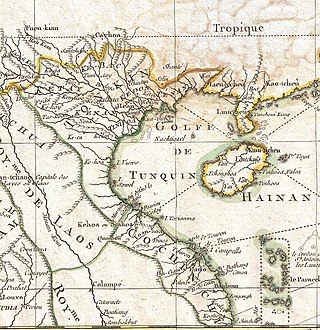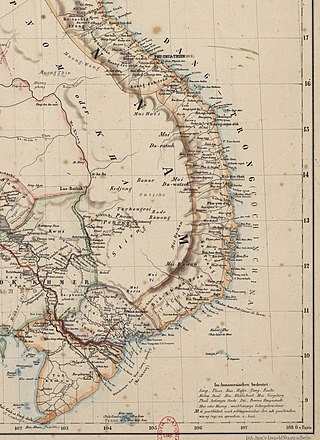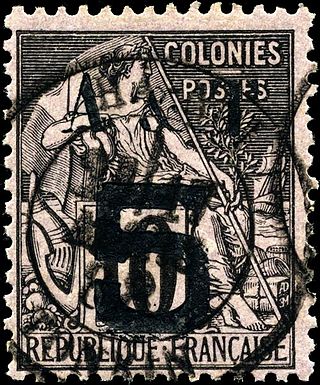This article needs additional citations for verification .(August 2008) |
French administration in Indochina began June 5, 1862, when the Treaty of Saigon ceded three provinces. By 1887 the French administered all of Indochina.
This article needs additional citations for verification .(August 2008) |
French administration in Indochina began June 5, 1862, when the Treaty of Saigon ceded three provinces. By 1887 the French administered all of Indochina.
The French invasion of Indochina was sparked off by the execution of Christian missionaries. With the defeat of Vietnamese Emperor Tự Đức signed the Treaty of Saigon, ceding Cochinchina's three eastern provinces. Later, the French forced the Emperor to place Cambodia under French protection. On June 18, 1867, the French seized the rest of Cochinchina and conquered the Mekong Delta and later Hanoi. By 1887, France controlled all of Indochina. [1]
Each of the provinces – Cambodia, Laos, Annam, Tonkin, Cochinchina and Kouang-Tchéou-Wan – had different legal statuses. Hence, political structure might differ from one province to another.
The first thing the French had to deal with was the royalty. Rather than abolishing the monarchy as the British had done in Burma, France preserved native monarchs in a suzerain relationship. The political structure resembled that of Cambodia and Laos, with France exercising ultimate control over legislative and executive powers.
The supreme executive authority lay in the hands of the governor, assisted by a Privy Council and a Colonial Council. The Privy Council resembled the Executive Council and the Colonial Council resembled the Legislative Assembly in the British colonial system. The colony in Cochinchina was divided into major districts and a French administrative officer was appointed as the head of each district. The Colonial Council focused on colonial laws, land, domestic transportation and public works. The Privy Council was in charge of finance, taxation, and militia.
The nobility, the monarchy and the hierarchy of mandarins, were preserved and they existed alongside the French. However, the executive authority remained in the hands of the résident-supérieur, assisted by a Privy Council and a Protectorate Council similar to Cochinchina. Each protectorate was divided into provinces under French Residents. However, in contrast with Cochinchina, the rule was less direct. The actual administration was carried out by the collaborating local officials under the supervision of their French opposite numbers, who never intervened directly unless there was a dire need to do so. Despite so, French control could not be challenged and remained absolute.
Unlike the rest of French Indochina, which were either a colony or protectorates, Kouang-Tchéou-Wan was a leased territory which France leased from China under a treaty for 99 years.
On paper, Cochinchina was the only portion with direct rule imposed. The province was legally annexed to the French under the Treaty of Saigon. The rest of the provinces, Tonkin, Annam, Cambodia and Laos, remained as French protectorates. However, the differences between direct and indirect rule "was a legal rather than a practical one".[ citation needed ] Political interference was as every bit intrusive in Cochinchina as Laos.
The French adopted a policy of assimilation rather than association. The policy of association allowed the colonialists to rule through native rulers while upholding their traditional cultures and hierarchy, similar to British rule in Malaya. However, the French ruled out that option and chose to adopt the policy of assimilation. This was due to the French experience in 1789 French Revolution and Napoleonic era. The Declaration of Rights of Man was based on the principle of egalité, liberté and fraternité for all subjects and citizens of France, and the colonies could not be an exception. French language was to be the language of administration. The whole Indochina would be "Frenchized". Napoleonic Code was introduced in 1879 into the five provinces, sweeping away the Confucianism that has existed for centuries in Indochina.
Doumer, who was sent by French government to administer Indochina in 1897, made a series of reforms that would last till the collapse of French authority in Indochina. First, he gave greater political autonomy to Cambodian monarch and limited the executive authority of resident-general in return for Cambodian recognition of French land titles and opening of its economy. In Annam, he decided to preserve the monarchy to gain legitimacy for the French. He created the High Council that included the French Privy Counsellors and Presidents of Chambers of Commerce. Financial system was reformed and refined in such a way that he was able to create a reserve.
The resulting policy of assimilation disregarded all Annamite traditions in favor of turning the Indochinese into Frenchmen. Unfortunately, the values and customs of the French are mostly conflicting with the traditions of the Indochinese. For example, The French valued individualism; the Indochinese appreciated their collectivism. Hence the destruction of many of Indochinese long-existing traditions provided a dangerous ground of resentment and rebellion. As reforms were introduced, new social classes were developed and Western thinking began to seep in, Annamite intellectuals began truly to understand the devastating effects of French influence on their society. Something had to change. Unfortunately, as most often in the struggle for independence, change meant war. Changes in the political and social consciousness of the Annamite population between 1920 and 1945—and the ability of the French to control numerous aspects of Annamite life, the alteration of the village economy and social relationships, and the introduction of a cash economy—all contributed to the onset of the Vietnam War.

French Indochina, officially known as the Indochinese Union and after 1947 as the Indochinese Federation, was a grouping of French colonial territories in Mainland Southeast Asia until its demise in 1954. It comprised Cambodia, Laos, the Chinese territory of Guangzhouwan, and the Vietnamese regions of Tonkin in the north, Annam in the centre, and Cochinchina in the south. The capital for most of its history (1902–1945) was Hanoi; Saigon was the capital from 1887 to 1902 and again from 1945 to 1954.

Tonkin, also spelled Tongkin, Tonquin or Tongking, is an exonym referring to the northern region of Vietnam. During the 17th and 18th centuries, this term referred to the domain Đàng Ngoài under Trịnh lords' control, including both the Northern and Thanh-Nghệ regions, north of the Gianh River. From 1884 to early 1945, this term was used for the French protectorate of Tonkin, composed of only the Northern region.

Annam, or Trung Kỳ (中圻), was a French protectorate and colony encompassing the territory of the Empire of Đại Nam in Central Vietnam. Before the protectorate's establishment, the name Annam was used in the West to refer to Vietnam as a whole; Vietnamese people were referred to as Annamites. The protectorate of Annam became a part of French Indochina in 1887, along with two other Vietnamese regions, Cochinchina in the South and Tonkin in the North. The region had a dual system of French and Vietnamese administration. The government of the Nguyễn Dynasty still nominally ruled Annam and Tonkin as the Empire of Đại Nam, with the emperor residing in Huế. In 1948, the protectorate was merged in the Provisional Central Government of Vietnam, which was replaced the next year by the newly established State of Vietnam. The French legally maintained the protectorate until they formally signed over sovereignty to the Bảo Đại and the government of the State of Vietnam in 1950 after signing the Élysée Accords in 1949. The region was divided between communist North Vietnam and anti-communist South Vietnam under the terms of the Geneva Accord of 1954.

The Nguyễn dynasty was the last Vietnamese dynasty, which was preceded by the Nguyễn lords and ruled the unified Vietnamese state independently from 1802 to 1883 before being under French protectorate. During its existence, the empire expanded into modern-day southern Vietnam, Cambodia, and Laos through a continuation of the centuries-long Nam tiến and Siamese–Vietnamese wars. With the French conquest of Vietnam, Nguyễn dynasty was forced to give up the sovereignty over parts of Southern Vietnam by France in 1862 and 1874, and after 1883 the Nguyễn dynasty only nominally ruled the French protectorates of Annam as well as Tonkin. They later canceled treaties with France and were the Empire of Vietnam for a short time until 25 August 1945.

Cochinchina or Cochin-China is a historical exonym for part of Vietnam, depending on the contexts. Sometimes it referred to the whole of Vietnam, but it was commonly used to refer to the region south of the Gianh River.

The French protectorate of Cambodia refers to the Kingdom of Cambodia when it was a French protectorate within French Indochina, a collection of Southeast Asian protectorates within the French colonial empire. The protectorate was established in 1863 when the Cambodian King Norodom requested the establishment of a French protectorate over his country, meanwhile Siam renounced suzerainty over Cambodia and officially recognised the French protectorate on Cambodia.

A concise postal history of French Annam protectorate and Tongking protectorate, former territories of colonial French Indochina, that were located in present-day Vietnam. Dates 1888 - 1892
The Indochinese Communist Party (ICP) was a political party which was transformed from the old Vietnamese Communist Party in October 1930. This party dissolved itself on 11 November 1945.

The French protectorate of Laos was a French protectorate in Southeast Asia of what is today Laos between 1893 and 1953—with a brief interregnum as a Japanese puppet state in 1945—which constituted part of French Indochina. It was established over the Siamese vassal, the Kingdom of Luang Phrabang, following the Franco-Siamese War in 1893. It was integrated into French Indochina and in the following years further Siamese vassals, the Principality of Phuan and Kingdom of Champasak, were annexed into it in 1899 and 1904, respectively.

French Cochinchina was a colony of French Indochina, encompassing the whole region of Lower Cochinchina or Southern Vietnam from 1862 to 1946. The French operated a plantation economy whose primary strategic product was rubber.

The Empire of Vietnam was a short-lived puppet state of Imperial Japan governing the former French protectorates of Annam and Tonkin between March 11 and August 25, 1945. At the end of its rule, the empire also successfully reclaimed Cochinchina as part of Vietnam.
The Treaty of Huế, concluded on 25 August 1883 between France and Vietnam, recognised a French protectorate over Annam and Tonkin. Dictated to the Vietnamese by the French administrator François-Jules Harmand in the wake of the French military seizure of the Thuận An forts, the treaty is often known as the 'Harmand Treaty'. Considered overly harsh in French diplomatic circles, the treaty was never ratified in France, and was replaced on 6 June 1884 with the slightly milder 'Patenôtre Treaty' or 'Treaty of Protectorate', which formed the basis for French rule in Vietnam for the next seven decades.

The Treaty of Huế or Protectorate Treaty was concluded on 6 June 1884 between France and Đại Nam. It restated the main tenets of the punitive Harmand Treaty of 25 August 1883, but softened some of the harsher provisions of this treaty. The treaty, which formed the basis for the protectorates of Annam and Tonkin, and for French colonial rule in Vietnam during the next seven decades, was negotiated by Jules Patenôtre, France's minister to China, and is often known as the Patenôtre Treaty. The treaty was signed on the Vietnamese side by Phạm Thận Duật and Tôn Thất Phan, representatives of the emperor Tự Đức’s court. The treaty marked the Nguyễn dynasty's second acceptance of French protectorate in central and northern Vietnam, but it was canceled by the Nguyễn dynasty on 11 March 1945.

The Provisional Central Government of Vietnam was a French-associated entity proclaimed in Vietnam during the First Indochina War. It was created as a transitional government replacing the French protectorates of Tonkin and Annam, until Cochinchina could be reunited with the rest of the country under a unified French-associated administration.

Auguste Jean-Marie Pavie was a French colonial civil servant, explorer and diplomat who was instrumental in establishing French control over Laos in the last two decades of the 19th century. After a long career in Cambodia and Cochinchina, Pavie became the first French vice-consul in Luang Prabang in 1886, eventually becoming the first Governor-General and plenipotentiary minister of the newly formed French colony of Laos.

The Mekong expedition of 1866–1868, conceived and promoted by a group of French colonial officers and launched under the leadership of captain Ernest Doudard de Lagrée, was a naval exploration and scientific expedition of the Mekong River on behalf of the French colonial authorities of Cochinchina. Its primary objective, besides scientific documentation, mapping, and the mission civilisatrice, was an assessment of the river's navigability in order to link the delta region and the port of Saigon with the riches of southern China and upper Siam. Ambitions were to turn Saigon into a successful commercial center such as British controlled Shanghai at the mouth of the Yangtze River.

Tonkin, or Bắc Kỳ (北圻), was a French protectorate encompassing modern Northern Vietnam. Like the French protectorate of Annam, Tonkin was still nominally ruled by the Nguyễn dynasty, but in 1886, the French separated Tonkin from the Nguyễn imperial court in Huế by establishing the office of "Viceroy". However, on 26 July 1897, the position of Viceroy was abolished, officially making the French resident-superior of Tonkin both the representative of the French colonial administration and the Nguyễn dynasty court in Huế, giving him the power to appoint local mandarins. In 1887, Tonkin became a part of the Union of Indochina.
In political science, direct rule is when an imperial or central power takes direct control over the legislature, executive and civil administration of an otherwise largely self-governing territory.

The French conquest of Vietnam (1858–1885) was a long and limited war fought between the Second French Empire, later the French Third Republic and the Vietnamese empire of Đại Nam in the mid-late 19th century. Its end and results were victories for the French as they defeated the Vietnamese and their Chinese allies in 1885, the incorporation of Vietnam, Laos, and Cambodia, and finally established French rules over constituent territories of French Indochina over Mainland Southeast Asia in 1887.